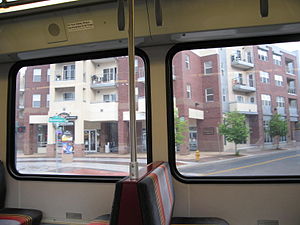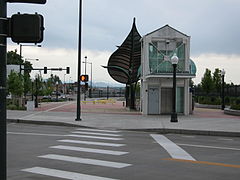- Regional Transportation District
-
- For the RTD that operated in Los Angeles, see Southern California Rapid Transit District.
Regional Transportation District Info Locale Denver Metro Area, Colorado Transit type Bus and light rail Number of lines 174 Daily ridership 313,590 boardings (2007)[1] Chief executive Phillip A. Washington
(General Manager)[2][3]Operation Began operation 1972 Operator(s) Regional Transportation District The Regional Transportation District, or RTD, was organized in 1969 and is the regional authority operating public transit services in eight of the twelve counties in the Denver-Aurora-Boulder Combined Statistical Area in Colorado. RTD is governed by a 15-member, publicly elected Board of Directors. Directors are elected to a four-year term and represent a specific district. Elections are staggered so that eight seats are open in one general election, seven in the next. The 2009 Board members are: Kent Bagley, District H; Barbara Brohl, District D; Noel Busck, District K; Juanita Chacon, District C; William M. Christopher, District J; Bruce Daly, District N; Bill James, District A; Lee Kemp, District I, Christopher Martinez, District B; William G. McMullen, District E; Jack O'Boyle, District G; Wally Pulliam, District L; John Tayer, District O and Tom Tobiassen, District F.[4]
RTD currently operates a bus and light rail system that has a service area of 2,337 square miles (6,050 km2). It employs 2,526 people and reported over 100 million boardings in calendar years 2007 and 2008 [5]. It had a $372 million budget for the year of 2008 and a $382 million for 2009. Google has RTD schedules attached to its trip planner, and 3rd party mobile applications are now available for the iPhone and other platforms.
RTD is working to deliver the voter-approved FasTracks rapid transit expansion that will add 122 miles (196 km) of new commuter rail and light rail, 18 miles (29 km) of bus rapid transit service, 21,000 new parking spaces at rail and bus stations, and enhance bus service for easy, convenient bus/rail connections across the eight-county district.
Contents
Timeline
- Pre-RTD: The principal provider of public transportation was the Denver Tramway Company, which served the City and County of Denver as well as older portions of Arvada, Aurora, Englewood, Golden, Lakewood, Westminster, and Wheat Ridge and smaller suburbs.
- 1969: RTD was created in the 47th session of the Colorado General Assembly to provide public transportation to five additional counties in the metropolitan area.
- 1969 - 1971: The Denver Tramway Company continues service under sponsorship of the City and County of Denver.
- October 1970: RTD found it needed to establish a Northern Operations Group (NOG) to provide service to Boulder and Longmont. RTD acquired the privately owned Denver-Boulder Bus Company, which also ran airport buses.
- 1971: Denver Metro Transit took over the privately owned Denver Tramway Company. Denver Metro Transit was an entity created by the City and County of Denver. Suburban service only continued for those suburbs willing to contribute a subsidy.
- 1972: RTD created a plan for a personal rapid transit (PRT) system in the area, and a transportation plan was completed—three years after the 1969 legislative mandate. This plan included 98 miles (158 km) of PRT and extensive bus service throughout the areas served by RTD. Later that year, the Urban Mass Transportation Administration (UMTA) selected RTD to develop PRT as a demonstration project.
- 1973: Residents voted for a sales tax of 1/2% over the six counties served by RTD for ten years; 20% of the funds would be used for expanded bus service and the other 80% were earmarked for PRT construction. The PRT project was eventually scrapped.
- July 1974: Denver Metro Transit became part of RTD.
- 1975-1977: RTD consolidated and expanded and improved service frequency. Service was expanded to routes that commercial carriers previously operated.
- 1978: Inflation caused RTD to implement a new fare structure.
- 1979: Federal approval was prepared for the 16th Street Mall in downtown Denver, originally known as Transitway. The project allowed express bus productivity to double and was eventually intersected by RTD's first light rail line, the D Line, at Stout and California streets.
- 1980: RTD reached a record number of weekday passengers, expanded the park-'n'-Ride system. It also acquired 216 new buses, 89 of which were articulated. Construction began on the 16th Street Mall. Work was also completed to make RTD's service more accessible to elderly and handicapped people.[1]
- September 1994: Downtown Express/High Occupancy Vehicle (HOV) lanes were opened to buses, and to carpools a year later.
- October 1994: RTD opened the Central Corridor light rail line, bringing rail transit back to the region.
- 2000: The Southwest Corridor light rail line opened.
- 2002: The Central Platte Valley spur of RTD's light rail service opened.
- April 2006: Unionized transit workers of the Amalgamated Transit Union went on strike for the first time in 24 years, citing increased health care costs, mandatory overtime, and disproportionate wage increases relative to upper management. Workers walked off the morning of April 3, shutting down the light rail system and decreasing bus service to about 45% of its normal routes, the remaining service being provided by existing RTD subcontractors Laidlaw, Connex, and First Transit. Laidlaw and Connex, whose workers are contracted rather than unionized, would take over many routes operated by RTD, albeit on a reduced schedule, while First Transit, whose workers are unionized, operated only its own routes due to its contract with its workers. A revised contract was approved by the union on April 7, and service resumed on April 10. The strike lasted a total of seven days, and although thousands of commuters were stranded by the strike, only above average backups were reported as customers made makeshift arrangements for commuting or waited out the strike for personal trips. [2][dead link]
- November 17, 2006: The Southeast Corridor, a component of the T-REX transportation project, opened.
Fleet
Gillig and Orion buses make up most of the fleet. MCI and Neoplan vehicles are used as express buses and regional buses. As of January 2010, the RTD light rail fleet has 125 light rail vehicles, serving 35 miles (56 km) of track.
Projects
Past projects
Downtown Express
This project added HOV lanes to I-25 north of downtown Denver. It also added several dedicated slip ramps for RTD buses to access several Park-n-Ride stations directly from the highway. At the south end of the HOV lanes, buses had direct routes into Union Station or Market Street Station. The HOV lanes extended from I-25 to US-36, allowing regional and express routes running along US 36 to downtown Denver to bypass congestion around the Turnpike Tangle. This project was completed in September 1994.
In 2006, the Downtown Express was renovated to include a toll lane, thereby converting the HOV lanes into HOT lanes. This allows SOV vehicles to pay a toll to use them. It was built to increase the overall usage and efficiency of the highway's HOV lanes. The project was completed on June 2, 2006.
Central Corridor
The Central Corridor, a 5.3 mile (8.5 km) light rail line, opened in October 1994. It was built along Welton Street, through the Five Points district along Stout Street and California Street, and following a railroad right-of-way from Colfax Avenue down to the intersection of I-25 and Broadway. This line was built without the aid of tax increases or federal funds; however, extensions have been funded by the Federal Transit Administration and new tax measures. This line was built from 30th/Downing as the northern terminus to I-25/Broadway as the southern terminus.
Southwest Corridor
After the success of the Central Corridor, the Southwest Corridor light rail route opened in July 2000. An 8.7 mile (13.9 km) light rail line, the route runs from the terminus of the Central Corridor at I-25 & Broadway to Mineral Avenue in Littleton with 5 existing stations. The line has been popular, and the park-n-Ride lots at its stations often experience parking shortages. This project built a light rail line from I-25/Broadway south to Littleton/Mineral along an existing railroad right-of-way next to Santa Fe Drive.
Central Platte Valley Corridor
In April 2002, the Central Platte Valley (CPV) spur opened. It is a 1.8-mile (2.9-km) branch with four stations that provides light rail access to numerous venues, including the Auraria Campus, Invesco Field at Mile High, the Pepsi Center, Six Flags, Union Station and Coors Field. This project built light rail lines from 10th/Osage to Union Station.
T-REX Project
In November 1999, Denver area voters approved a project, known as the T-REX, which involved reconstruction of I-25 between Broadway and Lincoln Avenue in Lone Tree, and I-225 between I-25 and Parker Road in Aurora, with widening of the road to 5 lanes and light rail being built. The highway project was completed on August 22, 2006. The light rail line known as the Southeast Corridor opened shortly after 11 a.m. on November 17, 2006. The line covers 19.1 miles (30.6 km) and includes thirteen new stations, with parking available at all but the Louisiana/Pearl station.
Projects under development
FasTracks: A major project to dramatically expand the metro area's rail service. The less densely populated north metro area will receive two commuter rail lines, while the west metro will receive a light rail line and a commuter rail line. In addition, a commuter rail line will connect Denver International Airport to downtown. Union Station will be redeveloped into the hub of the rail network, with a large mixed-use transit-oriented development built around it. Several existing lines will be extended. This project is scheduled to be completed in 2014[6].
References
- ^ RTD Facts
- ^ "Interim General Manager". http://www.rtd-denver.com/GeneralManager.shtml. Retrieved 2009-08-19.
- ^ Francis, Jeff (2009-06-25). "RTD gets interim general manager". MileHighNews.com. http://www.milehighnews.com/Articles-i-2009-06-25-211116.114125_RTD_gets_interim_general_manager.html. Retrieved 2009-08-19.
- ^ "RTD Board of Directors". http://www.rtd-denver.com/BoardDirectors.shtml. Retrieved 2009-08-19.
- ^ "RTD Facts and Figures". http://www.rtd-denver.com/factsAndFigures.shtml. Retrieved 2009-08-19.
- ^ Program Schedule: http://www.rtd-fastracks.com/main_31
- ^ Timeline between 1969 and 1982 provided from "RTD A History: 1969-82" published 1983 by the Regional Transportation District.
External links
- RTD's official website
- Transit Alliance - A non-profit coalition of 40 local governments, business associations and citizen groups promoting expanded rail and bus transit in the Denver Metro region.
- Passenger Advocacy for Rail Transit
Categories:- Bus transportation in Colorado
- Passenger rail transportation in Colorado
- Denver metropolitan area
- Transportation in Denver, Colorado
- Intermodal transport authorities
- Regional Transportation District
- Transportation in Aurora, Colorado
- Transit authorities with hybrid buses
- Transit authorities with natural gas buses
Wikimedia Foundation. 2010.







